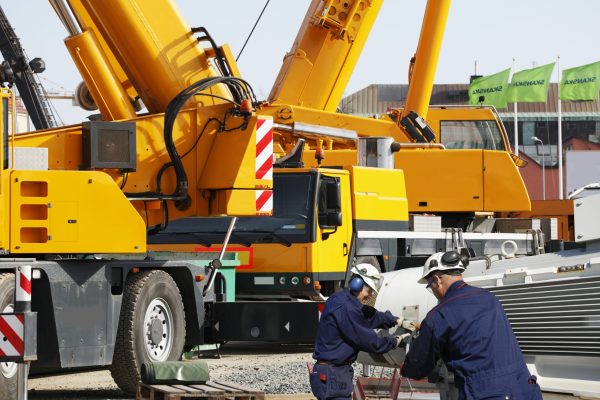
Employing asset tracking solutions for your construction business allows you to access and assess critical performance data of your assets in real-time, whether you’re on-site or not. When you can collect and access data, you’re able to maximize the utilization of assets that are essential for the daily operations across your sites and operations
With so many asset tracking and management options available to the construction industry, it’s difficult to know which one is the best option for you. In this post, we’ll help guide you towards the best choice for your assets and your business. Below, we’ve listed some of the most important features an asset tracking system can provide to your construction business.
Cloud-Based Mobile Access
Mobile access ensures that you know where your construction assets are, whether or not you’re on-site. Employees, contractors and managers already use a mobile device — why not let them use mobile capabilities to access the system’s database on-site, off-site or on the road? Data can be acquired through any smart device, including smartphones, tablets or laptop computers, with an app and/or a website. Most cloud solutions implement a “per user, per month” monthly pricing schedule, allowing for much more manageable costs. A cloud solution also means no hefty up-front or running costs and can usually be deployed instantly.
Modular Construction Tracking
Building something offsite? Modular projects require many of the same protocols as on-site builds; an asset tracking system allows project managers to access critical data, such as equipment details, materials used and even safety or health documents.
Project Management
It can be challenging to manage your equipment across multiple building sites and plants can be challenging for any construction company. An asset tracking and management system can even help with requisitions, logistics and purchase orders, allowing site managers to assign and allocate equipment to the right site at the right time. Use your asset tracking management system to create proper workflows to improve efficiencies and increase productivity.
Reduced Theft
One of the biggest challenges facing the construction industry is theft. People will often target small assets because they can be hidden and removed easily. But even larger assets are at risk for theft. Asset tracking tools help improve the security of your construction assets and reduce the risk of theft and loss by tracking and tagging your tools, machinery, vehicles, equipment and building materials. As an example, ZenduIT’s solar powered asset trackers are scalable asset tracking solution for large assets such as trailers, dry containers and heavy equipment. Such trackers protect assets of all sizes, providing movement alerts, detailed location and movement history, and much more.
More Safety For Your Construction Workers
Recent reports claim that accidents on a construction site are among the most frequent causes of injury or accidental death. Faulty equipment represents significant safety hazards to workers on your site; by effectively tracking, managing and maintaining construction machinery and other assets, you can help prevent accidents.
Schedule Repairs And Maintenance
Your site’s assets are critical for your business operation. One of the most important factors in managing construction equipment and tools involves knowing exactly what you have and how much they cost to operate. It’s also important to know when your assets require maintenance, repair or replacement.
Use asset tracking to record an asset’s lifecycle and determine its peak performance, as well as when it needs to be repaired. Collected data can generate an asset profile that enables you to plan a preventative maintenance schedule and avoid unplanned downtime. By assessing your asset’s overall “health”, you can determine which ones are profitable, and which ones have a greater cost of ownership than your budget allows.
Budgeting And Forecasting
Data can be used to understand business costs at each stage of your operation or project, with an eye on improving future budget issues.
What To Consider Before You Purchase An Asset Tracker For Your Construction Business
Asset tracking and management systems can be used in the construction industry in a number of different ways, and most solutions are scalable, meaning they can apply to small and medium construction businesses, as well as larger construction enterprises with multiple sites and plants.
By now, you’ve likely done your research into asset tracking options. As part of a comprehensive, end-to-end solution service, ZenduIT can help you choose the right asset tracking system for your construction operation. Our consultants will help you identify your company’s goals, as well as clarify what’s required from the proposed system to deliver optimal results. Moreover, our experts will help you build a system that’s scalable and can evolve with you as your business continues to grow. Here are some of the key pieces we would help you determine before making a purchase decision:
Can The System Record Your Asset Data?
In construction, the asset lifecycle starts with the decision to acquire or rent an asset, which can then be identified and tracked from acquisition to removal.
The right asset tracking system can manage the entire cycle process, collecting critical data at each stage. This allows contractors and project managers to determine the operational lifespan of an asset. By tracking assets such as equipment, tools, vehicles and more, construction companies can begin to understand the need for certain assets and help avoid costly outcomes such as unplanned downtime. It also enables you to figure out the remaining service life of all assets, so you can plan ahead and invest in new equipment when needed. From here, the system should be able to create reports to help you operate at maximum efficiency, such as maintenance schedules.
Is Data Tracked In Real-Time?
Real-time tracking produces specific data around asset usage and location. An effective asset tracking system can help you create an accurate database, with all of your assets registered and accounted for. Knowing the exact location of assets helps increase productivity and reduce job lead times. Trackers track and protect your equipment and other assets with detailed history of their movement and location, usage reports, maintenance monitoring to prevent breakdowns, misuse alerts and more.
Can It Record All Assets?
Beyond tools, vehicles and equipment, vital assets can also include “soft” assets, such as lease agreements, training information, safety and health protocols and other critical documentation. Your asset management system should be able to manage all assets for a complete overhaul of your business practices. A management system that creates detailed custom reporting can help ensure compliance across the organization, and can also be tailored to the needs of your business.
Do Your Employees Need Training?
Depending on the teams that require access, you’ll need to know how much training your workers need to operate the system. You should also be aware of training costs and how long it takes to train key stakeholders.
Conclusion
Asset tracking and management systems allow your business to maximize the assets you have, as well as their utilization. By applying these systems to the construction industry, asset tracking also allows project managers, contractors and managers to enhance the lifespan of their assets, and improve business operations. Curious to learn more about how telematics solutions can be used in construction fleets? Contact us today!

